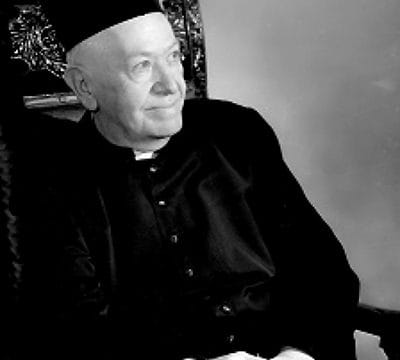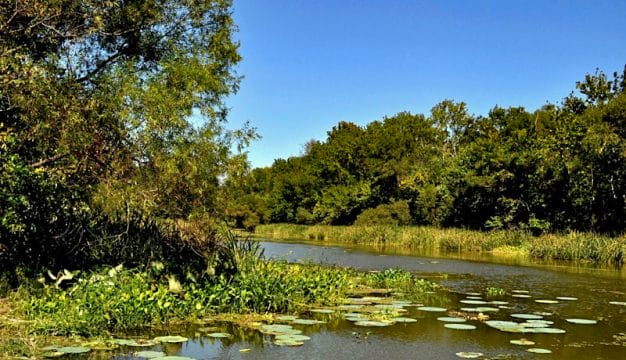Black Belt Region in Alabama
 Crossing Edmund Pettus Bridge
Depending on the criteria employed to characterize the area, the Black Belt of Alabama, named for its dark, rich soils, contains roughly between 12 and 21 counties in the central part of the state. Geographically, Alabama’s Black Belt is part of a larger crescent-shaped area known as the Southern Black Belt, which extends from Maryland to Texas. The region’s identity is rooted in both its physical and cultural geography and its historical development. During the twentieth century, Alabama’s Black Belt became a hotbed of activity for the civil rights movement in the South. In Macon County, Tuskegee Airmen trained at Tuskegee Army Airfield from 1941 through 1946. Montgomery County witnessed the Bus Boycott from 1955 to 1956. Highway 80 in Dallas, Lowndes, and Montgomery Counties shaped the route taken by participants from the Black Belt and beyond during the historic march for equal rights from Selma to Montgomery in 1965. And the Lowndes County Freedom Organization (later the Black Panther Party) was an outgrowth of that march.
Crossing Edmund Pettus Bridge
Depending on the criteria employed to characterize the area, the Black Belt of Alabama, named for its dark, rich soils, contains roughly between 12 and 21 counties in the central part of the state. Geographically, Alabama’s Black Belt is part of a larger crescent-shaped area known as the Southern Black Belt, which extends from Maryland to Texas. The region’s identity is rooted in both its physical and cultural geography and its historical development. During the twentieth century, Alabama’s Black Belt became a hotbed of activity for the civil rights movement in the South. In Macon County, Tuskegee Airmen trained at Tuskegee Army Airfield from 1941 through 1946. Montgomery County witnessed the Bus Boycott from 1955 to 1956. Highway 80 in Dallas, Lowndes, and Montgomery Counties shaped the route taken by participants from the Black Belt and beyond during the historic march for equal rights from Selma to Montgomery in 1965. And the Lowndes County Freedom Organization (later the Black Panther Party) was an outgrowth of that march.
Cultural geographers divide Alabama into two cultural areas. The first, the Midland traditional culture region, extends across the state from just above the Blackland Prairie north to the Tennessee border. The Midland Culture region covers portions of 33 states, including Alabama, and was settled by a diverse variety of ethnic groups with an agricultural heritage that developed into middle-class family farms. The second area is known as the Lower South traditional culture region, which includes customs and cultural heritage derived from its British, French, Caribbean, and African inhabitants. The region was characterized by a plantation system of agriculture. The Black Belt region lies along the boundary between these two major culture areas. The legacy of this plantation culture has left the region in a state of economic depression, underemployment, and poor social services. Once sought after for its rich soils, the Black Belt has become a region defined by its dire socioeconomic situation.
Black Belt Physical Geography
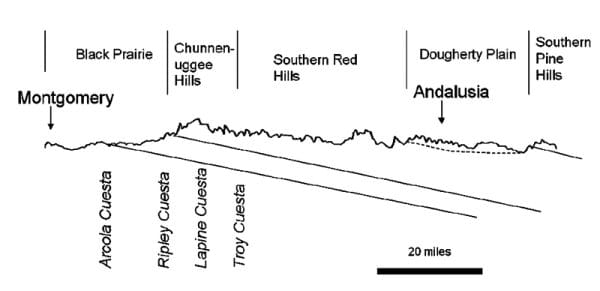 East Gulf Coastal Plain Cross-section
At the heart of Alabama’s Black Belt is the Ripley cuesta, a ridge with a steep north face and gentle, sloping southern face. This feature is known locally as the Chunnennuggee after the Bullock County ridge formation of the same name. A geological formation known as the Selma Chalk underlies the Blackland Prairie, a major physiographic component of the region. This sedimentary limestone bed was formed over millions of years in the shallow gulf waters that once covered modern-day Alabama during the Lower Tertiary Period, between 66 million to 38 million years ago. The Selma Chalk has since been uplifted and tilted toward the Gulf of Mexico. It is overlain with a layer of dark, fairly rich soils that are excellent for cultivating cotton, wheat, and rice with proper irrigation. The label “Black Belt,” in use for more than a century, is presumed to have derived from early settlers’ description of the abundant dark black soils found throughout the region.
East Gulf Coastal Plain Cross-section
At the heart of Alabama’s Black Belt is the Ripley cuesta, a ridge with a steep north face and gentle, sloping southern face. This feature is known locally as the Chunnennuggee after the Bullock County ridge formation of the same name. A geological formation known as the Selma Chalk underlies the Blackland Prairie, a major physiographic component of the region. This sedimentary limestone bed was formed over millions of years in the shallow gulf waters that once covered modern-day Alabama during the Lower Tertiary Period, between 66 million to 38 million years ago. The Selma Chalk has since been uplifted and tilted toward the Gulf of Mexico. It is overlain with a layer of dark, fairly rich soils that are excellent for cultivating cotton, wheat, and rice with proper irrigation. The label “Black Belt,” in use for more than a century, is presumed to have derived from early settlers’ description of the abundant dark black soils found throughout the region.
Traditionally, 17 Alabama counties—Barbour, Bullock, Butler, Choctaw, Crenshaw, Dallas, Greene, Hale, Lowndes, Macon, Marengo, Montgomery, Perry, Pike, Russell, Sumter, and Wilcox—were included in the region. The crescent-shaped Black Belt stretches across the mid-section of Alabama from the Chattahoochee River in the east westward to Mississippi. The uppermost part of the East Gulf Coastal Plain, one of the state’s five physiographic sections, forms the northern boundary of Alabama’s Black Belt. The area is dominated by relatively flat and well-drained terrain interspersed with low undulating hills. Elevations in northern parts of the plains rise to an average of 600 feet. The Black Belt is geographically distinguished from higher elevations to the north and east by a band of hills along the fall line, where rivers flow onto flat bottom lands and form several large alluvial plains. The thick, rich, and fertile sedimentary soils deposited on these flood plains attracted both Native American and early colonial settlers to the area.
Rivers and streams from several large basins—the Sipsey-Warrior, Coosa-Tallapoosa, Alabama-Cahaba, Tombigbee, and Chattahoochee—course through the Black Belt. When cotton was the dominant crop grown in the region, the Black Belt’s many navigable waterways enabled growers to transport their harvests to the docks in Mobile for shipment abroad. Reliance on these waterways continues into the present. In 1995, more than 25 million tons of channel traffic flowed along the Black Warrior-Tombigbee alone.
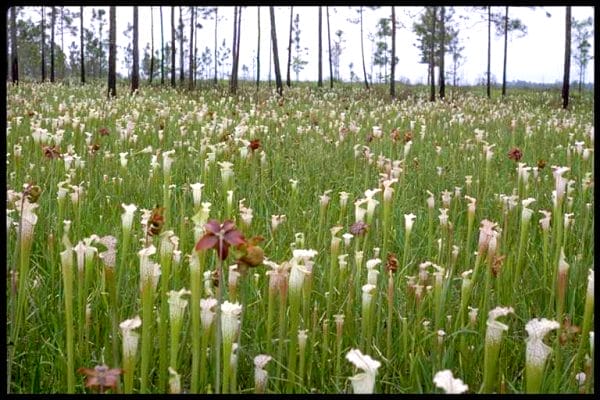 White-topped Pitcher Plants
A large portion of the Black Belt region experiences the lowest rainfall amounts within the state, with mean averages approaching 56 inches or less, but the region still has an abundant variety of native plants and animals. In 2008, approximately 70 percent of Alabama lands were forested, with coverage in the 17 traditional Black Belt counties totaling slightly more than 74 percent. On the whole, timberland throughout the Black Belt is dominated by stands of loblolly and shortleaf pines. Some western and northwestern sections of the Black Belt are home to mixed oak and pine forests, and oak-gum-cypress stands can be found along flood plains. According to the Forest Inventory and Analysis (FIA) Program of the USDA Forest Service, virtually all the forested acreage in Alabama’s Traditional Black Belt counties, with the exception of some 6,000 acres in Perry County, is classified as timberland capable of producing a minimum of 20 cubic feet of industrial wood per acre per year.
White-topped Pitcher Plants
A large portion of the Black Belt region experiences the lowest rainfall amounts within the state, with mean averages approaching 56 inches or less, but the region still has an abundant variety of native plants and animals. In 2008, approximately 70 percent of Alabama lands were forested, with coverage in the 17 traditional Black Belt counties totaling slightly more than 74 percent. On the whole, timberland throughout the Black Belt is dominated by stands of loblolly and shortleaf pines. Some western and northwestern sections of the Black Belt are home to mixed oak and pine forests, and oak-gum-cypress stands can be found along flood plains. According to the Forest Inventory and Analysis (FIA) Program of the USDA Forest Service, virtually all the forested acreage in Alabama’s Traditional Black Belt counties, with the exception of some 6,000 acres in Perry County, is classified as timberland capable of producing a minimum of 20 cubic feet of industrial wood per acre per year.
The Cultural Black Belt
An understanding of cultural development in the Black Belt is essential to any attempt at describing the cultural geography of the state. When discussed as a geographical and geological entity, the Black Belt Region is easily defined, but its definition as a cultural entity is more difficult to agree upon. Considerable debate exists concerning the cultural characteristics that set the region apart from other areas of the state. Different interest groups have different ways of defining the region based on their agendas, many of which focus on improving the economic and social conditions in this most impoverished part of the state.
 Black Belt Action Commission
For example, the previously mentioned traditional definition, which is based on agriculture, includes 17 Alabama counties. The definition used by the University of Alabama Institute for Rural Health consists of 19 counties excluding Montgomery, Russell, and Pike counties while including Escambia, Washington, Clarke, Pickens, and Conecuh Counties. The Alabama Black Belt Heritage Area definition also comprises 19 counties, but the list excludes Russell, Barbour, and Pike Counties and includes Bibb, Washington, Clarke, Pickens, and Conecuh Counties. In August 2004, Alabama governor Bob Riley signed an executive order creating the Governor’s Commission for Action in Alabama’s Black Belt, which targeted 12 Alabama counties: Bullock, Choctaw, Dallas, Greene, Hale, Lowndes, Macon, Marengo, Perry, Pickens, Sumter, and Wilcox. The commission was charged with the task of effecting measurable positive change in the quality of life in the Black Belt region through the identification of specific problems or needs, formulation of solutions including solicitation of outside funding and grants, and implementation of programs. The executive order did not provide a concise definition of the Black Belt.
Black Belt Action Commission
For example, the previously mentioned traditional definition, which is based on agriculture, includes 17 Alabama counties. The definition used by the University of Alabama Institute for Rural Health consists of 19 counties excluding Montgomery, Russell, and Pike counties while including Escambia, Washington, Clarke, Pickens, and Conecuh Counties. The Alabama Black Belt Heritage Area definition also comprises 19 counties, but the list excludes Russell, Barbour, and Pike Counties and includes Bibb, Washington, Clarke, Pickens, and Conecuh Counties. In August 2004, Alabama governor Bob Riley signed an executive order creating the Governor’s Commission for Action in Alabama’s Black Belt, which targeted 12 Alabama counties: Bullock, Choctaw, Dallas, Greene, Hale, Lowndes, Macon, Marengo, Perry, Pickens, Sumter, and Wilcox. The commission was charged with the task of effecting measurable positive change in the quality of life in the Black Belt region through the identification of specific problems or needs, formulation of solutions including solicitation of outside funding and grants, and implementation of programs. The executive order did not provide a concise definition of the Black Belt.
When land in Alabama was opened for settlement early in the nineteenth century, white immigrant farmers and their families from bordering areas poured into the state in the period known as “Alabama Fever.” Some immigrants were subsistence farmers, and others were cotton planters who brought African slaves with them to work as field hands and domestic servants. The Black Belt began a socioeconomic decline in the late nineteenth century, with productivity per acre falling as the once fertile soils became depleted as a result of natural causes and poor farming practices. Other factors that most likely decreased productivity include emancipation and the Great Migration. The Black Belt cotton industry suffered an additional and devastating blow in the mid-1910s as a consequence of the boll weevil invasion. One benefit of the boll weevil, however, was a shift to more diversified crops in the region. Today, Black Belt farmers, like their counterparts in other areas, produce cattle, corn, cotton, eggs, poultry, peanuts, pigs, soybeans, wheat, hay, and timber. A combination of gentle topography and extensive clay deposits make parts of the Black Belt ideal locations for a thriving catfish industry, which has for the most part enjoyed good fortune in Alabama’s midsection. In the last few years, the catfish industry has experienced a slight downturn resulting from rising costs of production and competition from lower-priced foreign imports. Other Black Belt entrepreneurs have taken advantage of an ancient saline aquifer lying deep under the Selma Chalk beds to raise inland shrimp.
 Catfish Processing Plant
During the last half of the twentieth century, the Black Belt agricultural landscape, as in the rest of Alabama, has undergone dramatic changes. In 1950, Alabama had approximately 200,000 farms. By 2002, the number of reported farms had dropped to roughly 45,000. Between 2002 and 2007, however, the number of farms increased 8 percent to 48,753; average size, however, has declined 6 percent from 197 acres in 2002 to 185 acres in 2007. In the traditional Black Belt in 2002, there were 7,296 farms averaging 374 acres in size. By 2007, the number of farms in the 17 traditional Black Belt counties had increased to 7,808, a 7 percent expansion. As in the state as a whole, average size declined 6 percent to 351 acres. Black Belt farms still are typically much larger in acreage and worth more in total value but smaller in value per acre than farms outside the region. The disparity seems to be related to the larger average size of Black Belt farms and mono-crop nature of agricultural activity in the region. Although counties within and adjacent to the Black Belt enjoy marked agricultural diversity, farmland in the region is being converted steadily to commercial timber or hunting preserves. Three Black Belt counties—Hale, Choctaw, and Wilcox—are ranked among the top five producers of primary timber products.
Catfish Processing Plant
During the last half of the twentieth century, the Black Belt agricultural landscape, as in the rest of Alabama, has undergone dramatic changes. In 1950, Alabama had approximately 200,000 farms. By 2002, the number of reported farms had dropped to roughly 45,000. Between 2002 and 2007, however, the number of farms increased 8 percent to 48,753; average size, however, has declined 6 percent from 197 acres in 2002 to 185 acres in 2007. In the traditional Black Belt in 2002, there were 7,296 farms averaging 374 acres in size. By 2007, the number of farms in the 17 traditional Black Belt counties had increased to 7,808, a 7 percent expansion. As in the state as a whole, average size declined 6 percent to 351 acres. Black Belt farms still are typically much larger in acreage and worth more in total value but smaller in value per acre than farms outside the region. The disparity seems to be related to the larger average size of Black Belt farms and mono-crop nature of agricultural activity in the region. Although counties within and adjacent to the Black Belt enjoy marked agricultural diversity, farmland in the region is being converted steadily to commercial timber or hunting preserves. Three Black Belt counties—Hale, Choctaw, and Wilcox—are ranked among the top five producers of primary timber products.
Demographics
Alabama’s modern Black Belt region, and the Southern Black Belt in general, continue to be defined by the legacy of slavery and the plantation agriculture system. Its characteristics include low taxes on property, high rates of poverty and unemployment, low-achieving schools, and high rates of out-migration. The Black Belt is home to a large proportion of Alabama’s African American population and has a high number of single-parent households, high teen birth rates, and poor access to health-care services. The area also has a long history of support for the Democratic Party. Numerous similarities can be drawn between the Black Belt region and developing nations in both Latin America and sub-Saharan Africa, not the least being extractive economies, plantation systems, and heavy dependence on more developed economies. Traits usually associated with agrarian society such as large family and household size persist within the region today.
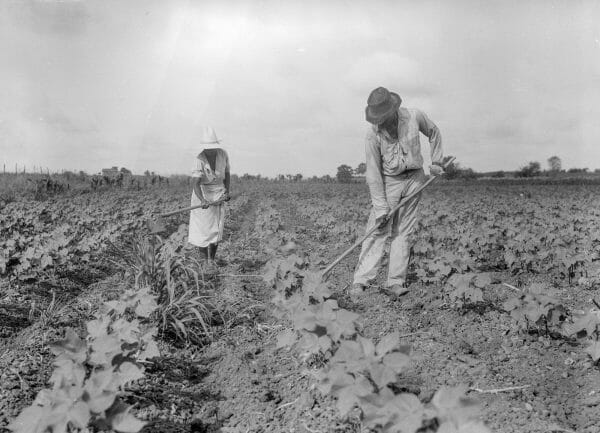 Tenant Farmers Hoeing a Cotton Field
By 1820, seven of the 17 traditional Black Belt counties—Butler, Dallas, Green, Marengo, Montgomery, Perry, and Wilcox—had been chartered. In that early period, the Black Belt was home to just 19.44 percent of the state’s total population. By 1870, however, roughly 40 percent of Alabama’s populace lived in the 17 traditional Black Belt counties. In the decades immediately following emancipation, African Americans left the Black Belt counties in large numbers. Those who remained found themselves in a new cultural landscape, with comparably strict segregation and limited opportunity. Both freed slaves and poor whites in the Black Belt often were enmeshed in an exploitive system of tenant farming and sharecropping, in effect a new form of slavery.
Tenant Farmers Hoeing a Cotton Field
By 1820, seven of the 17 traditional Black Belt counties—Butler, Dallas, Green, Marengo, Montgomery, Perry, and Wilcox—had been chartered. In that early period, the Black Belt was home to just 19.44 percent of the state’s total population. By 1870, however, roughly 40 percent of Alabama’s populace lived in the 17 traditional Black Belt counties. In the decades immediately following emancipation, African Americans left the Black Belt counties in large numbers. Those who remained found themselves in a new cultural landscape, with comparably strict segregation and limited opportunity. Both freed slaves and poor whites in the Black Belt often were enmeshed in an exploitive system of tenant farming and sharecropping, in effect a new form of slavery.
Trends in migration and the general population decline in Black Belt counties continued into the twentieth century. Between 1910 and 2000, the population in Alabama’s 67 counties increased just over 108 percent. In the same period, population in the 17 traditional Black Belt counties increased less than one percent. If Montgomery County figures are removed from the statistic, population declined slightly more than 30 percent in the remaining 16 counties. A more recent census estimate in 2010 indicates that the proportion of all Alabamians residing in the 17 traditional Black Belt counties has plummeted to about 12 percent. If the largely urbanized populace of Montgomery County, no longer considered a Black Belt county, is removed from the 2006 statistic, the resulting proportion becomes only about 7 percent.
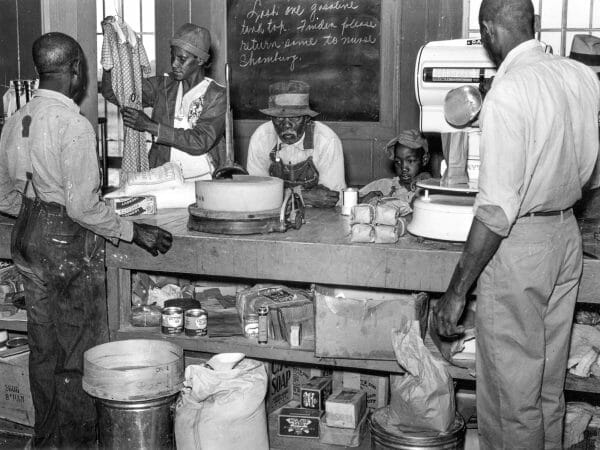 Gee’s Bend Cooperative Store
One of the defining cultural traits for a county’s inclusion in the various models of Alabama’s Black Belt is an African American population at or above 50 percent. The existence of a high percentage of African Americans residing in Black Belt counties is in some ways a relic of the plantation system of agriculture, which influenced settlement of the region in the nineteenth century. The number of African Americans living in the Black Belt totaled about 38 percent of the population in 1820. By 1860, it had increased to about 64 percent and later to an all-time high of approximately 73 percent in 1900. Since that time, the proportion of African Americans residing in the region has steadily declined to 43.72 percent in 2000. The Black Belt Action Committee’s 12-county designation may more accurately embody the heartland of Alabama’s Black Belt region. In 1900, the proportion of African Americans residing in those 12 counties was 79.09 percent. Throughout the first half of the twentieth century, African Americans residing in the committee’s 12 counties exceeded 70 percent. By 2010, this amount had dropped to 49.82 percent.
Gee’s Bend Cooperative Store
One of the defining cultural traits for a county’s inclusion in the various models of Alabama’s Black Belt is an African American population at or above 50 percent. The existence of a high percentage of African Americans residing in Black Belt counties is in some ways a relic of the plantation system of agriculture, which influenced settlement of the region in the nineteenth century. The number of African Americans living in the Black Belt totaled about 38 percent of the population in 1820. By 1860, it had increased to about 64 percent and later to an all-time high of approximately 73 percent in 1900. Since that time, the proportion of African Americans residing in the region has steadily declined to 43.72 percent in 2000. The Black Belt Action Committee’s 12-county designation may more accurately embody the heartland of Alabama’s Black Belt region. In 1900, the proportion of African Americans residing in those 12 counties was 79.09 percent. Throughout the first half of the twentieth century, African Americans residing in the committee’s 12 counties exceeded 70 percent. By 2010, this amount had dropped to 49.82 percent.
From emancipation to the period known as the Great Migration, which took place during much of the twentieth century, the overall population of African Americans in the Black Belt declined but their proportion of the whole rose in relation to the white population. For the period from 1910 to 2000, 13 of the traditional 17 Black Belt counties lost more than 25 percent of their population. The Great Migration in Alabama, in part, was driven by declines in economic opportunity within the Black Belt brought on by mechanization of farming and a steady decline in cotton agriculture. In addition, the rise of the coal and steel industry sparked economic growth and opportunities outside of the region.
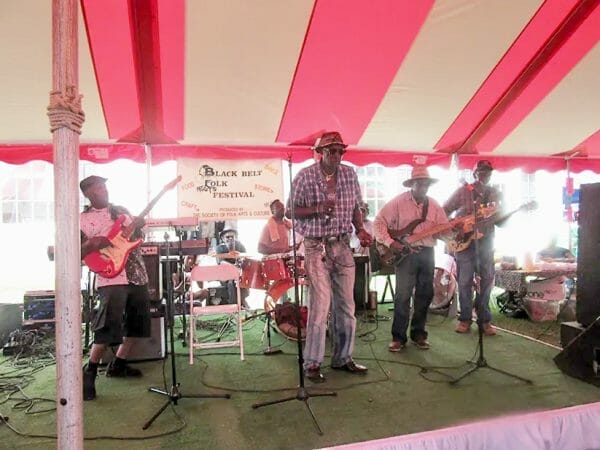 Black Belt Roots Festival
Average per-capita personal income in Alabama for 2015 was 80.25 percent of the U.S. average. The state ranked 48 out of the 50 states and the District of Columbia. The estimated average number of persons living in poverty in Alabama in 2015 was approximately 19.2 percent, whereas the U.S. average during the same period was 14.8 percent. Nine out of the 10 poorest counties in Alabama—Barbour, Dallas, Greene, Hale, Lowndes, Macon, Perry, Sumter, and Wilcox—are in the Black Belt. Shifting population and high rates of out-migration in Alabama are logical consequences of lagging economic growth, poverty, and lack of employment opportunities. Additional economic push factors brought on by structural changes in Black Belt agricultural geography have contributed to a rural-to-urban population shift.
Black Belt Roots Festival
Average per-capita personal income in Alabama for 2015 was 80.25 percent of the U.S. average. The state ranked 48 out of the 50 states and the District of Columbia. The estimated average number of persons living in poverty in Alabama in 2015 was approximately 19.2 percent, whereas the U.S. average during the same period was 14.8 percent. Nine out of the 10 poorest counties in Alabama—Barbour, Dallas, Greene, Hale, Lowndes, Macon, Perry, Sumter, and Wilcox—are in the Black Belt. Shifting population and high rates of out-migration in Alabama are logical consequences of lagging economic growth, poverty, and lack of employment opportunities. Additional economic push factors brought on by structural changes in Black Belt agricultural geography have contributed to a rural-to-urban population shift.
Alabama has comparatively few large urban spaces. In the 2010 Census, the state’s population density totaled 94.4 persons per square mile, 27th in the nation. Only three southern states—Arkansas, Mississippi, and Texas—had lower population density values for the period. Of 454 towns and cities listed in U.S. census data for the year 2000, 390 Alabama municipalities have a population of less than 10,000 people. In order from highest to lowest, the five most populated municipalities in Alabama are Birmingham, Montgomery, Mobile, Huntsville, and Tuscaloosa. Montgomery is the only municipality located within the traditional Black Belt region.
Many of Alabama’s high-growth counties straddle interstate highway systems or lie in the northern and northeastern sections of the state. Accordingly, recent infrastructural development in Alabama has followed the geography of demographic change, leaving Black Belt residents in some areas with limited access to essential services. In an effort to effect positive change in basic quality of life, the Black Belt region has become the focus of a variety of governmental and non-governmental programs to improve socioeconomics within the region. Gov. Bob Riley’s Black Belt Improvement Initiative cited several problems that need to be addressed including little or no economic opportunities, high levels of unemployment, high rates of out-migration, low levels of educational achievement, high incidence of teen pregnancies, low birth weight (most likely attributed to poor nutrition), births to unwed mothers, and single-parent families. Over the last few years, improvement has been made on several fronts. However, problems facing Black Belt counties are not easily solved.
Cultural Legacy of the Black Belt
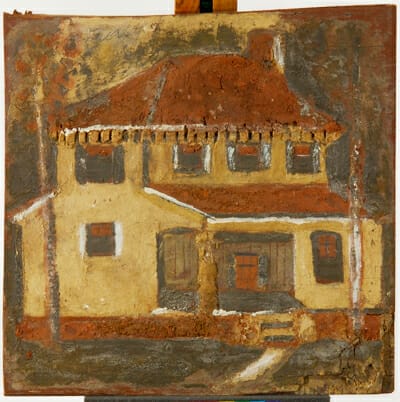 Untitled (Two-Story High Style House), 1975
Despite the hardships and difficulties faced by residents of Alabama’s traditional Black Belt, the region has produced a rich variety of artists, musicians, writers, and other noted public figures. A few notable natives of the Black Belt include Ralph Abernathy, civil rights activist; Nat “King” Cole, musician; Congressman Artur Davis; Morris Dees Jr., founder of Southern Poverty Law Center; singer and songwriter Eddie Kendricks; civil rights activist Rosa Parks; novelist and artist Zelda Sayre Fitzgerald; author and civil rights activist Coretta Scott King; artist Jimmy Lee Sudduth; and storyteller, author, and journalist Kathryn Tucker Windham.
Untitled (Two-Story High Style House), 1975
Despite the hardships and difficulties faced by residents of Alabama’s traditional Black Belt, the region has produced a rich variety of artists, musicians, writers, and other noted public figures. A few notable natives of the Black Belt include Ralph Abernathy, civil rights activist; Nat “King” Cole, musician; Congressman Artur Davis; Morris Dees Jr., founder of Southern Poverty Law Center; singer and songwriter Eddie Kendricks; civil rights activist Rosa Parks; novelist and artist Zelda Sayre Fitzgerald; author and civil rights activist Coretta Scott King; artist Jimmy Lee Sudduth; and storyteller, author, and journalist Kathryn Tucker Windham.
Several organizations within and outside the region are charged with preservation of Black Belt culture, including the Alabama Black Belt Heritage Area, Alabama Rural Heritage Foundation, Alabama’s Front Porches, Alabama Humanities Alliance, Alabama Trust for Historic Preservation, Black Belt Community Foundation, Black Belt Treasures, Center for the Study of the Black Belt, and the Rural Studio. Many of these organizations as well as numerous unnamed communities in the Black Belt organize annual festivals celebrating Black Belt culture, crafts, and cuisine.
In January 2023, Pres. Joseph R. Biden signed legislation that created the Black Belt National Heritage Area, establishing the second such designation in Alabama, the first being the Muscle Shoals National Heritage Area. National Heritage Areas are public-private partnerships created to protect and promote communities that are distinctive because of their culture, history, resources, and environment. The legislation was sponsored by Sen. Richard Shelby just prior to his retirement from the U.S. Congress. The funding associated with the designation falls within the National Park Service’s budget.
Further Reading
- Jeffries, Hasan Kwame. Bloody Lowndes: Civil Rights and Black Power in Alabama’s Black Belt. New York: New York University Press, 2009.
- McDonald, Robin, and Valerie Pope Burnes. Visions of the Black Belt: A Cultural Survey of the Heart of Alabama. Tuscaloosa: University of Alabama Press, 2015.
- Prior, John W., and David W. S. Wong. “Exploring different dimensions in defining the Alabama Black Belt.” GeoJournal 87(June 2022): 1-18.
- Tullos, Allen. “The Black Belt.” Southern Spaces, April 19, 2004; https://southernspaces.org/2004/black-belt.

